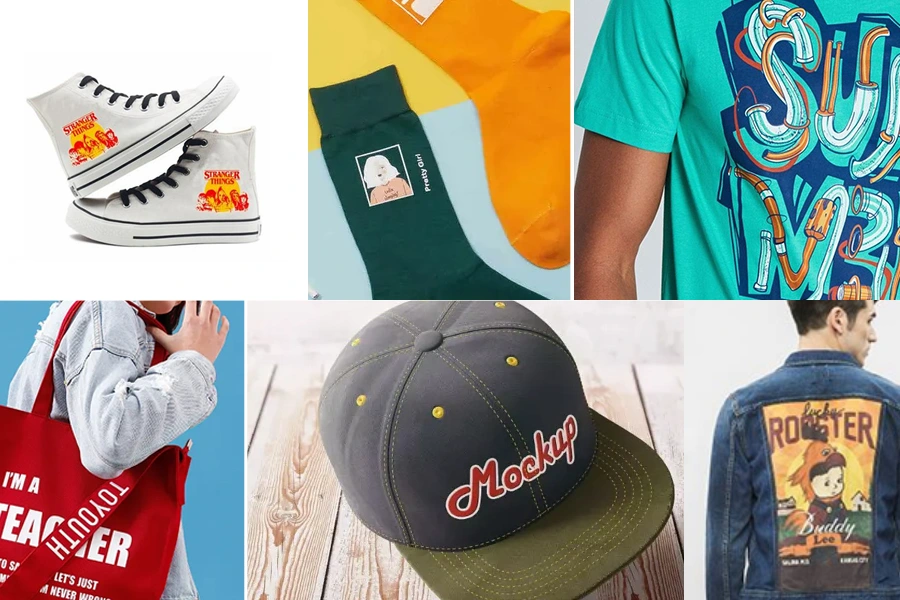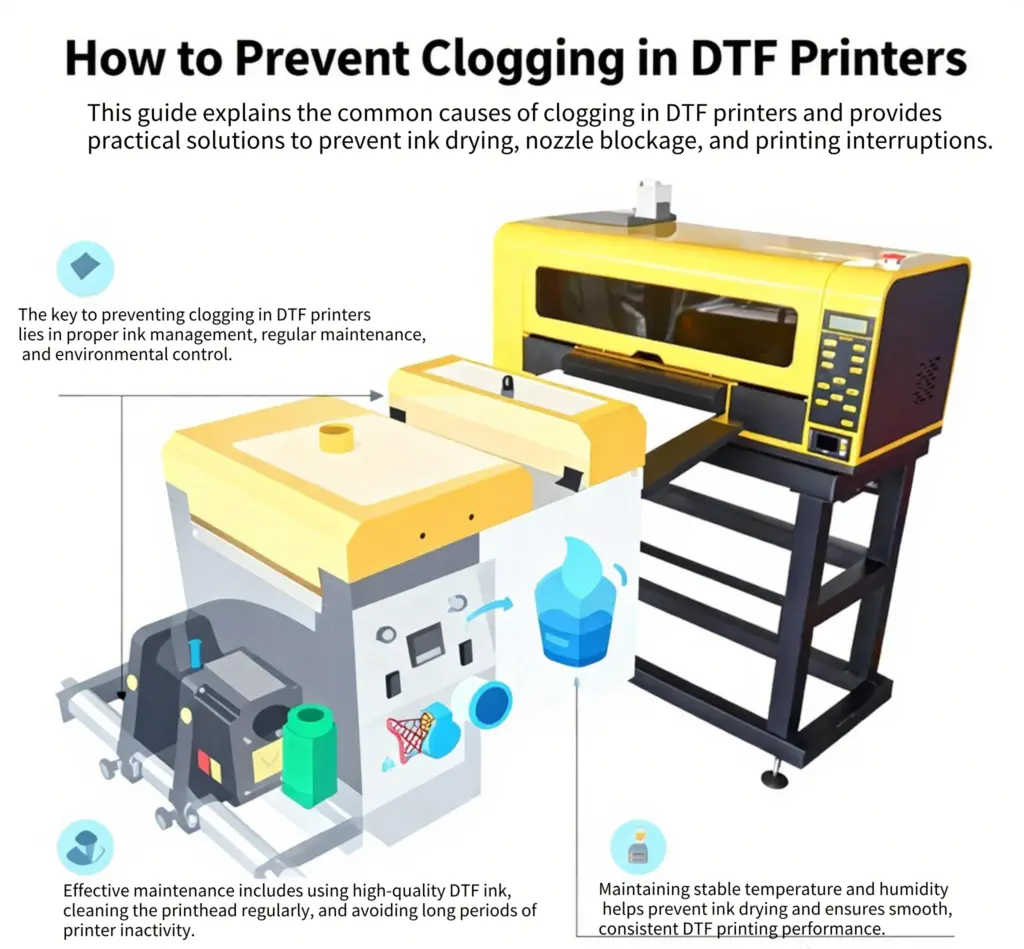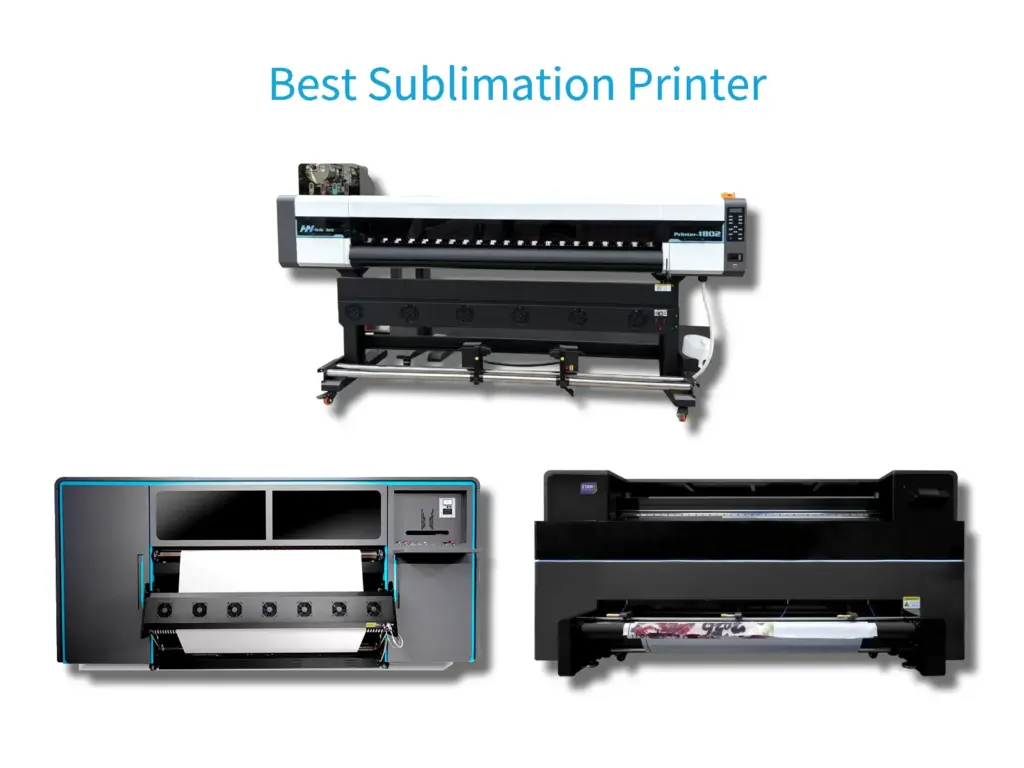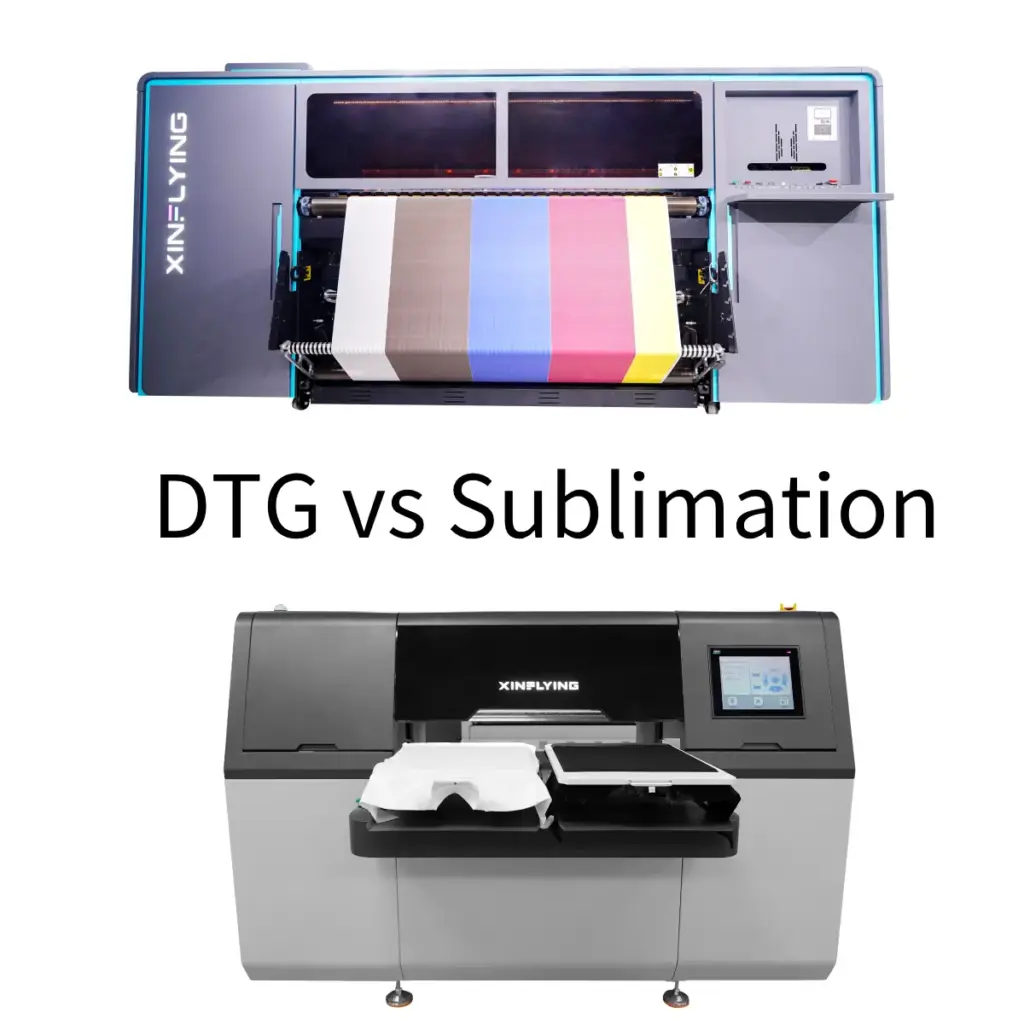Jeśli chodzi o drukowanie wzorów na tkaninie, na rynku dostępne są różne metody. Dwie popularne techniki to Direct-to-Fabric (DTF) nadruk i druk sublimacyjny. Na tym blogu, zbadamy ich podstawowe zasady, kluczowe różnice, Zastosowania, zalety i wady, i ostatecznie określić, która metoda najlepiej odpowiada konkretnym wymaganiom.
Podstawowe drukowanie DTF

Co to jest drukowanie DTF?
Druk DTF, znany również jako Druk bezpośrednio na tkaninie, to najnowocześniejsza technika stosowana do przenoszenia wzorów na różnego rodzaju tkaniny. Metoda ta polega na drukowaniu projektów na specjalnej folii, który jest następnie przenoszony na tkaninę za pomocą ciepła i ciśnienia. Proces pozwala uzyskać wysoką jakość, żywe nadruki na szerokiej gamie tkanin, co czyni go popularnym wyborem w przemyśle tekstylnym. W odróżnieniu od tradycyjnych metod, Druk DTF zapewnia elastyczność tworzenia skomplikowanych wzorów i żywych obrazów, które wyróżniają się na odzieży.
Jak działa drukowanie DTF?
Proces drukowania DTF rozpoczyna się od stworzenia pożądanego projektu na komputerze. Gdy projekt będzie już gotowy, jest drukowany na specjalnej folii za pomocą Atrament DTF. Następnie zadrukowaną folię umieszcza się na tkaninie, i oba są poddawane działaniu ciepła i ciśnienia przy użyciu prasy termicznej.
Podczas tego kroku, atrament z folii ulega przemianie fazowej ze stałej w gazową, bez przejścia przez fazę ciekłą. Dzięki temu cząsteczki atramentu osadzają się bezpośrednio we włóknach tkaniny, powodując długotrwałe i żywe nadruki.
Podstawy druku sublimacyjnego

Co to jest drukowanie sublimacji?
Drukowanie sublimacji to najnowocześniejsza metoda przenoszenia wzorów na tkaninę za pomocą ciepła i ciśnienia. Proces ten polega na przekształceniu cząstek stałych atramentu w stan gazowy z pominięciem fazy ciekłej. Następnie gaz przenika przez tkaninę i zestala się, co pozwala uzyskać żywe i trwałe wydruki. W odróżnieniu od tradycyjnych metod druku, druk sublimacyjny zapewnia elastyczność tworzenia złożonych wzorów i obrazów, które pozostają żywe nawet po wielokrotnym praniu.
Jak działa druk sublimacyjny?
Proces rozpoczyna się od stworzenia pożądanego projektu na komputerze. Po sfinalizowaniu projektu, jest drukowany na specjalnym papier do sublimacji używając atramenty sublimacyjne. Zadrukowany papier jest następnie umieszczany na tkaninie, i oba są poddawane działaniu ciepła i ciśnienia przy użyciu prasy termicznej.
Podczas tego kroku, atrament ulega sublimacji, przejście ze stanu stałego bezpośrednio w stan gazowy. Wysoka temperatura powoduje, że cząsteczki atramentu otwierają się i łączą z włóknami tkaniny, w wyniku czego nadruki są osadzone w samej tkaninie.
Kluczowe różnice między drukiem DTF a sublimacją
Teraz, przyjrzyjmy się kluczowym różnicom pomiędzy drukiem DTF a drukiem sublimacyjnym, koncentrując się na procesie aplikacyjnym, kompatybilność tkanin, i intensywność kolorów.
Proces aplikacji
Druk DTF polega na przeniesieniu materiału na folię, a następnie nałożeniu go na tkaninę za pomocą ciepła i ciśnienia. Zapewnia większą stabilność przelewów i możliwość ich długoterminowego przechowywania.
Druk sublimacyjny przenosi stałe cząsteczki atramentu w stan gazowy bez fazy ciekłej. Rezultatem są spójne kolory i żywe wydruki.
Kompatybilność z tkaniny
Druk DTF jest wszechstronny i może być stosowany na szerokiej gamie tkanin, dzięki czemu nadaje się do różnych projektów.
Druk sublimacyjny najlepiej sprawdza się na podłożach poliestrowych i powlekanych polimerami, dzięki czemu idealnie nadaje się do odzieży sportowej i przedmiotów spersonalizowanych.
Żywotność koloru
Druk DTF zapewnia żywe rezultaty na dowolnym kolorze tkaniny, natomiast sublimacja najlepiej sprawdza się na tkaninach w jasnych kolorach i nie drukuje skutecznie bieli.
Trwałość
Wydruki DTF są trwałe i odporne na zużycie, z transferami odpornymi na blaknięcie i zachowującymi przejrzystość w miarę upływu czasu.
Nadruki sublimacyjne charakteryzują się dużą trwałością, szczególnie na poliestrze, dzięki przemianie cząstek atramentu z gazu w ciało stałe, co zapewnia integrację wzorów z tkaniną.
Plusy i minusy druku DTF
Teraz, gdy już omówiliśmy podstawowe zasady DTF i nadruk sublimacyjny, Zagłębmy się w konkretne zalety i wady Druk DTF. Zrozumienie tych kluczowych aspektów zapewni cenny wgląd w przydatność tej metody do różnych zastosowań.
Plusy druku DTF
1. Żywe kolory
Jedna z wyróżniających się zalet Druk DTF jest jego zdolność do tworzenia żywych i przyciągających wzrok kolorów na tkaninie. Proces pozwala uzyskać wyjątkowe nasycenie kolorów, czego efektem są projekty, które zachwycają wyrazistością. Ta funkcja sprawia Druk DTF idealny wybór do zastosowań, w których priorytetem jest intensywność kolorów, takie jak modna odzież, koszulki sportowe, i gadżety promocyjne.
2. Idealny do skomplikowanych projektów
Kolejna istotna zaleta Druk DTF jest jego zdolność do precyzyjnego renderowania skomplikowanych i szczegółowych projektów. Niezależnie od tego, czy są to skomplikowane wzory, cienkie linie, lub rozbudowana grafika, co to jest druk DTF doskonale radzi sobie z uchwyceniem niuansów złożonych projektów. To sprawia, że jest to preferowany wybór do tworzenia efektownej wizualnie odzieży i akcesoriów wymagających nadruków w wysokiej rozdzielczości.
Wady drukowania DTF
1. Nie nadaje się do wszystkich tkanin
Natomiast druk DTF oferuje wszechstronność pod względem kompatybilności z tkaninami, może nie być odpowiedni dla wszystkich rodzajów tkanin. Niektóre specjalistyczne materiały lub mieszanki mogą stwarzać wyzwania podczas stosowania tej metody, wymagając od dekoratorów dokładnej oceny właściwości tkaniny przed przystąpieniem do drukowania DTF. Ważne jest, aby wziąć pod uwagę takie czynniki, jak skład tkaniny, tekstura, i splot, aby zapewnić optymalne rezultaty.
2. Dłuższy proces w porównaniu do innych metod
Kolejną kwestią związaną z drukiem DTF jest czas potrzebny na cały proces. Od przygotowania projektu i folii po przeniesienie jej na tkaninę, metoda ta zazwyczaj wymaga dłuższego czasu przetwarzania w porównaniu z niektórymi technikami alternatywnymi. Chociaż wyniki są często warte inwestycji w czasie, Dekoratorzy powinni uwzględniać harmonogramy produkcji przy wyborze druku DTF do swoich projektów.
Plusy i minusy druku sublimacyjnego
Teraz, przyjrzyjmy się konkretnym zaletom i wadom druku sublimacyjnego. Zrozumienie tych kluczowych aspektów zapewni cenny wgląd w przydatność tej metody do różnych zastosowań.
Plusy druku sublimacyjnego
1. Trwałe nadruki
Druk sublimacyjny zapewnia wyjątkową trwałość, co czyni go preferowanym wyborem do zastosowań wymagających długotrwałych projektów. Proces polega na przekształceniu stałych cząstek atramentu w stan gazowy, pozwalając im przeniknąć przez tkaninę i zestalić się. Dzięki temu nadruki są osadzone w samej tkaninie, zwiększając ich odporność na blaknięcie i zużycie. Co to jest druk sublimacyjny gwarantuje, że projekty zachowają żywotność i przejrzystość przez długi czas, nawet po wielokrotnym praniu i długotrwałym użytkowaniu.
2. Nadaje się do szerokiej gamy tkanin
Jedną z wyjątkowych zalet druku sublimacyjnego jest jego kompatybilność z szeroką gamą tkanin, w tym podłoża poliestrowe i powlekane polimerami. Ta wszechstronność sprawia, że idealnie nadaje się do różnych zastosowań, takich jak odzież sportowa, artykuły promocyjne, spersonalizowane prezenty, i więcej. Możliwość tworzenia żywych nadruków na różnych rodzajach tkanin rozszerza potencjalne zastosowania druku sublimacyjnego w różnych branżach.
Wady druku sublimacyjnego
1. Ograniczone opcje kolorów
Ograniczeniem druku sublimacyjnego są stosunkowo ograniczone możliwości kolorystyczne w porównaniu z innymi metodami druku. Doskonale radzi sobie z tworzeniem żywych kolorów na kompatybilnych tkaninach, mogą pojawić się ograniczenia przy próbie uzyskania określonych odcieni lub odcieni. Dekoratorzy powinni dokładnie ocenić swoje wymagania dotyczące kolorów i rozważyć alternatywne metody, jeśli poszukują szerszego spektrum kolorów w swoich projektach.
2. Nie nadaje się do ciemnych tkanin
Kolejną kwestią związaną z drukiem sublimacyjnym jest jego zgodność z kolorami tkanin. Ta metoda nie jest idealna w przypadku tkanin w ciemnych kolorach, ponieważ opiera się na białej warstwie bazowej w celu uzyskania optymalnej intensywności kolorów. Doskonale sprawdza się w tworzeniu żywych nadruków na jasnych tkaninach, dekoratorzy mogą potrzebować zbadać alternatywne techniki podczas pracy z ciemniejszymi odcieniami tkanin.
Sublimacja vs DTF, Które wybrać?
Decydując się pomiędzy sublimacją a DTF (Bezpośrednio do filmu) metody drukowania, ważne jest, aby wziąć pod uwagę specyficzne potrzeby i charakterystykę każdej metody. Oto kilka czynników, które należy wziąć pod uwagę przy wyborze pomiędzy drukiem sublimacyjnym a drukiem DTF:

Rodzaj tkaniny
Sublimację stosuje się zazwyczaj w przypadku tkanin na bazie poliestru, podczas gdy DTF można stosować na szerszej gamie tkanin, w tym bawełna, poliester, i mieszanki. Jeśli pracujesz głównie z tkaninami poliestrowymi, sublimacja może być najlepszym wyborem. Jeśli pracujesz z różnymi rodzajami tkanin, DTF może oferować większą elastyczność.
Żywotność koloru
Druk sublimacyjny zazwyczaj pozwala uzyskać żywsze i trwalsze kolory w porównaniu z drukiem DTF. Jeśli jakość kolorów jest dla Twoich projektów najwyższym priorytetem, sublimacja może być lepszym wyborem.- Szczegółowość i rozdzielczość: Druk DTF pozwala uzyskać większą szczegółowość i rozdzielczość w porównaniu do druku sublimacyjnego. Jeśli pracujesz nad skomplikowanymi projektami lub wzorami, DTF może oferować lepsze wyniki.
Koszt i wyposażenie
Druk sublimacyjny wymaga specjalistycznych tuszy sublimacyjnych, drukarki, i papier transferowy, co może być droższe niż sprzęt drukarski DTF. Druk DTF może być bardziej opłacalną opcją dla tych, którzy chcą rozpocząć działalność poligraficzną przy ograniczonym budżecie.
Łatwość użycia
Druk sublimacyjny polega na procesie wymiany ciepła, podczas gdy druk DTF wymaga użycia proszku topliwego i prasy termicznej. Niektórzy użytkownicy mogą uznać sublimację za prostszą i przyjazną dla użytkownika, podczas gdy inni mogą preferować większe opcje kontroli i dostosowywania oferowane przez druk DTF.
Przyjazny dla środowiska
Druk sublimacyjny uważany jest za bardziej przyjazny dla środowiska, ponieważ wytwarza minimalną ilość odpadów i nie wymaga użycia wody ani rozpuszczalników. Druk DTF może generować więcej odpadów ze względu na folię transferową stosowaną w procesie.
Czy mogę używać proszku DTF na papierze sublimacyjnym??
NIE, Proszek DTF nie jest kompatybilny z papierem sublimacyjnym. Proszek DTF przeznaczony jest do stosowania z foliami DTF, podczas gdy papier sublimacyjny jest używany z atramentami sublimacyjnymi w innym procesie drukowania. Mieszanie tych dwóch opcji może skutkować gorszą jakością transferu i uszkodzeniem sprzętu. Ważne jest, aby do każdej metody druku używać odpowiednich materiałów.
Czy DTF jest lepszy od sublimacji??
Wybór pomiędzy DTF (Bezpośrednio do filmu) i sublimacji zależy od Twoich konkretnych potrzeb i preferencji. Obie metody mają swoje zalety i ograniczenia:
Druk DTF
- Umożliwia druk na szerszej gamie tkanin, w tym bawełna, poliester, i mieszanki.
- Zapewnia większą szczegółowość i rozdzielczość w przypadku skomplikowanych projektów.
- Można uzyskać bardziej teksturowane wykończenie w porównaniu do sublimacji.
- Umożliwia drukowanie białym tuszem na ciemnych tkaninach.
Druk sublimacyjny
- Tworzy żywe i trwałe kolory, zwłaszcza na tkaninach na bazie poliestru.
- Bardziej przyjazny dla środowiska, ponieważ wytwarza minimalną ilość odpadów i nie wymaga wody ani rozpuszczalników.
- Łatwy w użyciu i idealny do drukowania na przedmiotach takich jak odzież, kubki, i produkty promocyjne.
- Nadaje się do produkcji wielkoseryjnej i masowej personalizacji.
Wniosek
W istocie, dekoratorzy i producenci powinni dokładnie ocenić swoje specyficzne wymagania przy wyborze metody druku DTF i sublimacji. Decyzja powinna opierać się na takich czynnikach, jak elastyczność zastosowania, kompatybilność tkanin, opcje kolorów, i względy dotyczące trwałości. Ogólnie, obie techniki oferują cenne rozwiązania w zakresie tworzenia żywych i trwałych nadruków na różnych tkaninach, przyczyniając się do stale zmieniającego się krajobrazu dekoracji tekstylnych.






